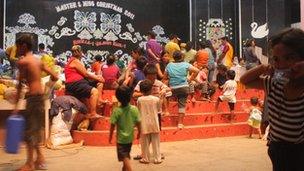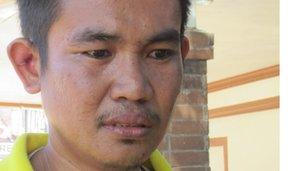Philippines floods: A Christmas to forget in Mindanao
- Published

This school in northern Mindanao has been preparing for Christmas, but is being used for survivors
When Jerry Mamonguy last saw this wife and three children, they were clinging on to the roof of their home as it was washed down-river.
"My neighbour's house slammed into mine. Everyone fell in the water and was pulled by the undertow," he said.
He is now on a desperate search to find out what happened to his family - a hunt that has taken him to evacuation centres and morgues around the coastline of northern Mindanao.
We met him as he came out of one of the main funeral parlours in Cagayan de Oro City. More than 60 bodies were there, but he recognised none of them.
As he headed off to his next destination, he looked broken.
Another woman at the mortuary, Catherine Cabahug Ramos, was also visibly upset.
She had identified her mother's body earlier in the day, gone back home, then when she came to collect it, found it had already been claimed by someone else.
Outside the building, people were making rudimentary coffins - but it was clear they could not meet the demand.
It is obvious that the authorities are struggling to cope with the sheer scale of the disaster.
At the morgue we visited, some of the bodies had been moved to a nearby landfill site, simply to get rid of the smell.
And in Iligan City, which was also badly affected by the storm, mayor Lawrence Cruz came to a difficult decision.
"We have decided, after consultation with our city health officer, that we should start digging graves for the bodies and bury them temporarily because they are already in the advanced state of decomposition," he told local media.
Water challenge
But it is not just the dead that are an urgent issue - many of the living are also in need of basic essentials like food, water and shelter.

Jerry Mamonguy has had no luck as yet finding his family
According to both World Vision and Unicef, which are both providing aid in the region, adequate drinking water is currently the biggest challenge.
When we visited one of Cagayan de Oro's evacuation centres - a building that is usually used as a school - 15 people were living in every room.
When a water truck arrived, everyone picked up plastic buckets and bottles and went running towards it, eager to get as much as they could.
Each one of them has a tale to tell from the day the storm barrelled into the region.
One little boy showed me a scar from where he was hit by a large piece of corrugated iron. A lady of 86 described how she was shivering and crying at the time she was rescued.
Some of the schools and community halls they are now living in still have Christmas decorations - but for many people here on the northern coast of Mindanao, this is likely to be a Christmas they would rather forget.
- Published18 December 2011